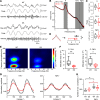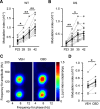Impaired θ-γ Coupling Indicates Inhibitory Dysfunction and Seizure Risk in a Dravet Syndrome Mouse Model
- PMID: 33234612
- PMCID: PMC7821857
- DOI: 10.1523/JNEUROSCI.2132-20.2020
Impaired θ-γ Coupling Indicates Inhibitory Dysfunction and Seizure Risk in a Dravet Syndrome Mouse Model
Abstract
Dravet syndrome (DS) is an epileptic encephalopathy that still lacks biomarkers for epileptogenesis and its treatment. Dysfunction of NaV1.1 sodium channels, which are chiefly expressed in inhibitory interneurons, explains the epileptic phenotype. Understanding the network effects of these cellular deficits may help predict epileptogenesis. Here, we studied θ-γ coupling as a potential marker for altered inhibitory functioning and epileptogenesis in a DS mouse model. We found that cortical θ-γ coupling was reduced in both male and female juvenile DS mice and persisted only if spontaneous seizures occurred. θ-γ Coupling was partly restored by cannabidiol (CBD). Locally disrupting NaV1.1 expression in the hippocampus or cortex yielded early attenuation of θ-γ coupling, which in the hippocampus associated with fast ripples, and which was replicated in a computational model when voltage-gated sodium currents were impaired in basket cells (BCs). Our results indicate attenuated θ-γ coupling as a promising early indicator of inhibitory dysfunction and seizure risk in DS.
Keywords: Dravet syndrome; Nav1.1; epilepsy; interneurons; sodium channels.
Copyright © 2021 the authors.
Figures










Comment in
-
Symphony Conductors Lose the Baton: Role of Fast-Spiking Interneurons in Orchestrating DS.Epilepsy Curr. 2021 Mar 31;21(3):192-193. doi: 10.1177/15357597211003550. eCollection 2021 May-Jun. Epilepsy Curr. 2021. PMID: 34867101 Free PMC article. No abstract available.
Similar articles
-
A Transient Developmental Window of Fast-Spiking Interneuron Dysfunction in a Mouse Model of Dravet Syndrome.J Neurosci. 2018 Sep 5;38(36):7912-7927. doi: 10.1523/JNEUROSCI.0193-18.2018. Epub 2018 Aug 13. J Neurosci. 2018. PMID: 30104343 Free PMC article.
-
Preictal dysfunctions of inhibitory interneurons paradoxically lead to their rebound hyperactivity and to low-voltage-fast onset seizures in Dravet syndrome.Proc Natl Acad Sci U S A. 2024 Jun 4;121(23):e2316364121. doi: 10.1073/pnas.2316364121. Epub 2024 May 29. Proc Natl Acad Sci U S A. 2024. PMID: 38809712 Free PMC article.
-
Focal and generalized seizure activity after local hippocampal or cortical ablation of NaV 1.1 channels in mice.Epilepsia. 2020 Apr;61(4):e30-e36. doi: 10.1111/epi.16482. Epub 2020 Mar 19. Epilepsia. 2020. PMID: 32190912 Free PMC article.
-
Changing Landscape of Dravet Syndrome Management: An Overview.Neuropediatrics. 2020 Apr;51(2):135-145. doi: 10.1055/s-0040-1701694. Epub 2020 Feb 20. Neuropediatrics. 2020. PMID: 32079034 Review.
-
Activity of drugs and components of natural origin in the severe myoclonic epilepsy of infancy (Dravet syndrome).Cent Nerv Syst Agents Med Chem. 2015;15(2):95-8. doi: 10.2174/1871524915666150430161321. Cent Nerv Syst Agents Med Chem. 2015. PMID: 25924876 Review.
Cited by
-
Third-order motifs are sufficient to fully and uniquely characterize spatiotemporal neural network activity.Sci Rep. 2023 Jan 5;13(1):238. doi: 10.1038/s41598-022-27188-6. Sci Rep. 2023. PMID: 36604489 Free PMC article.
-
Effects of Several Classes of Voltage-Gated Ion Channel Conductances on Gamma and Theta Oscillations in a Hippocampal Microcircuit Model.Front Comput Neurosci. 2021 Apr 1;15:630271. doi: 10.3389/fncom.2021.630271. eCollection 2021. Front Comput Neurosci. 2021. PMID: 33867962 Free PMC article.
-
Medial septum parvalbumin-expressing inhibitory neurons are impaired in a mouse model of Dravet syndrome.Epilepsia. 2025 Jul 7:10.1111/epi.18532. doi: 10.1111/epi.18532. Online ahead of print. Epilepsia. 2025. PMID: 40622667
-
Deciphering in silico the Role of Mutated Na V 1.1 Sodium Channels in Enhancing Trigeminal Nociception in Familial Hemiplegic Migraine Type 3.Front Cell Neurosci. 2021 May 31;15:644047. doi: 10.3389/fncel.2021.644047. eCollection 2021. Front Cell Neurosci. 2021. PMID: 34135733 Free PMC article.
-
Bad Timing for Epileptic Networks: Role of Temporal Dynamics in Seizures and Cognitive Deficits.Epilepsy Curr. 2021 Mar 16;21(3):15357597211001877. doi: 10.1177/15357597211001877. Online ahead of print. Epilepsy Curr. 2021. PMID: 33724060 Free PMC article.
References
-
- Almog Y, Brusel M, Anderson K, Rubinstein M (2019) Early hippocampal hyperexcitability followed by disinhibition in a mouse model of Dravet syndrome. bioRxiv. doi: https://doi.org/10.1101/790170.
Publication types
MeSH terms
Substances
Grants and funding
LinkOut - more resources
Full Text Sources
Medical
Molecular Biology Databases
Research Materials
